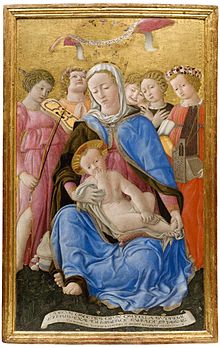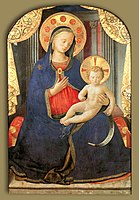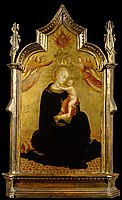
In art, a Madonna is a representation of Mary, either alone or with her child Jesus. These images are central icons for both the Catholic and Orthodox churches. The word is from Italian ma donna 'my lady' (archaic). The Madonna and Child type is very prevalent in Christian iconography, divided into many traditional subtypes especially in Eastern Orthodox iconography, often known after the location of a notable icon of the type, such as the Theotokos of Vladimir, Agiosoritissa, Blachernitissa, etc., or descriptive of the depicted posture, as in Hodegetria, Eleusa, etc.

Filippino Lippi was an Italian painter working in Florence, Italy during the later years of the Early Renaissance and first few years of the High Renaissance.

Simone Martini was an Italian painter born in Siena. He was a major figure in the development of early Italian painting and greatly influenced the development of the International Gothic style.

Lorenzo Monaco was an Italian painter of the late Gothic to early Renaissance age. He was born Piero di Giovanni in Siena, Italy. Little is known about his youth, apart from the fact that he was apprenticed in Florence. He was influenced by Giotto and that artist's followers Spinello Aretino and Agnolo Gaddi.

Ambrogio Lorenzetti or Ambruogio Laurati was an Italian painter of the Sienese school. He was active from approximately 1317 to 1348. He painted The Allegory of Good and Bad Government in the Sala dei Nove in Siena's Palazzo Pubblico. His elder brother was the painter Pietro Lorenzetti.

Pietro Lorenzetti or Pietro Laurati was an Italian painter, active between c. 1306 and 1345. Together with his younger brother Ambrogio, he introduced naturalism into Sienese art. In their artistry and experiments with three-dimensional and spatial arrangements, the brothers foreshadowed the art of the Renaissance.

Filippo Lippi, also known as Lippo Lippi, was an Italian painter of the Quattrocento and a Carmelite Priest.

Maestà[maeˈsta], the Italian word for "majesty", designates a classification of images of the enthroned Madonna with the child Jesus, the designation generally implying accompaniment by angels, saints, or both. The Maestà is an extension of the "Seat of Wisdom" theme of the seated "Mary Theotokos", "Mary Mother of God", which is a counterpart to the earlier icon of Christ in Majesty, the enthroned Christ that is familiar in Byzantine Mosaics. Maria Regina is an art historians' synonym for the iconic image of Mary enthroned, with or without the Child.
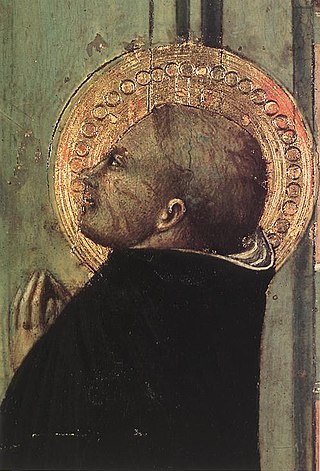
For the village near Livorno, see Sassetta, Tuscany
Domenico di Bartolo, born in Asciano, Siena, was a Sienese painter who became active during the early Renaissance period. He was inaccurately named by the famous painter, writer and historian Giorgio Vasari as the nephew of well-reputed Italian artist Taddeo di Bartolo, who is featured in Vasari's Lives of the Most Excellent Painters, Sculptors, and Architects. By the early 1400s, Domenico di Bartolo was one of Siena's artists most influenced by the new Florentine style of painting. During the time that he was active and working, Domenico was the only Sienese painter to have received commissions by clients in Florence. Domenico was also employed by Lorenzo Vecchietta, otherwise referred to as Lorenzo di Pietro, to work alongside him for the fresco The Care of the Sick, which is today considered a masterpiece of the Pilgrim's Hall in the hospital Santa Maria della Scala (Siena).
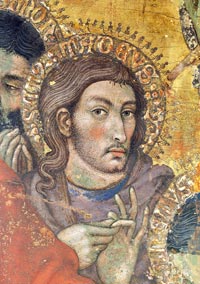
Taddeo di Bartolo, also known as Taddeo Bartoli, was an Italian painter of the Sienese School during the early Renaissance. He is among the artists profiled in Vasari's biographies of artists or Vite. Vasari claims he is the uncle of Domenico di Bartolo.

Lippo Memmi was an Italian painter from Siena. He was the foremost follower of Simone Martini, who was his brother-in-law.

Italian Renaissance painting is the painting of the period beginning in the late 13th century and flourishing from the early 15th to late 16th centuries, occurring in the Italian Peninsula, which was at that time divided into many political states, some independent but others controlled by external powers. The painters of Renaissance Italy, although often attached to particular courts and with loyalties to particular towns, nonetheless wandered the length and breadth of Italy, often occupying a diplomatic status and disseminating artistic and philosophical ideas.
The decade of the 1450s in art involved many significant events, especially in sculpture.
Andrea Vanni was an Italian painter of the early Renaissance, active mainly in his native Siena.
Bartolomeo Bulgarini, also known as Bulgarino or Bologhini, was an Italian painter of the Trecento period in Siena both before and after the Black Death.

Siena is a city in Tuscany, Italy. It is the capital of the province of Siena.

The Basilica of Our Lady of Humility or Madonna dell'Umiltà is a Renaissance-style, Roman Catholic Marian basilica in Pistoia, region of Tuscany, Italy.

The Pinacoteca Nazionale is a national museum in Siena, Tuscany, Italy. Inaugurated in 1932, it houses especially late medieval and Renaissance paintings from Italian artists. It is housed in the Brigidi and Buonsignori palaces in the city's center: the former, built in the 14th century, it is traditionally identified as the Pannocchieschi family's residence. The Palazzo Bichi-Buonsignori, although built in the 15th century, has a 19th-century neo-medieval façade based on the city's Palazzo Pubblico.
